Physical Address
304 North Cardinal St.
Dorchester Center, MA 02124
The main types of VIN – usual VIN (uVIN) and differentiated VIN (dVIN) – each have distinctive clinical and pathologic features. This terminology has been incorporated into the LAST standardization project for HPV-associated lesions ( Chapter 5 ).
Although traditionally VIN has been graded I, II, or III, VIN I has an unproven precancerous potential, and usually corresponds to the limited atypia of most condylomas. VIN is now reserved for dVIN and high-grade uVIN (formerly usual VIN II or III).
The incidence of uVIN has almost doubled over the past few decades, with a striking increase in younger women; currently those most often affected are <40 years of age.
Risk factors include evidence of HPV (such as condyloma acuminatum) and herpes infection, HIV-positivity, smoking, and other factors identical to those for cervical cancer ( Chapter 5 ). Some cases are associated with lichen sclerosus, although the latter is more closely associated with dVIN.
The typical presentation is a pruritic, burning, or asymptomatic, white, pink, red, or pigmented lesion that may be plaque-like, papular, or verruciform, and be clinically misinterpreted as a non-neoplastic epithelial disorder ( Chapter 1 ).
Involved sites in decreasing order of frequency are labium minus, posterior fourchette, labium majus, perianal skin, and periclitoral skin. Involvement of multiple sites is common.
In up to 50% of cases, synchronous or metachronous HPV-related squamous intraepithelial lesions (SILs) or invasive squamous cell carcinomas (ISqCCs) are present in other sites (cervix, vagina, urethra, perineum, anus). Some multifocal lesions are clonal.
The normal epithelial maturation is lost with replacement by keratinocytes with increased N:C ratio and variable nuclear pleomorphism, hyperchromasia, chromatin clumping, multinucleation, and mitotic figures, including abnormal mitoses. The cells are typically aneuploid.
Dyskeratotic cells, corps ronds (apoptotic bodies), and poorly formed keratin pearls may be seen. The affected epithelium may be acanthotic, parakeratotic, hyperkeratotic, or combinations thereof, often with bulbous expansion into the underlying stroma, a finding that can be misconstrued as invasion.
Skin appendages, most commonly pilosebaceous units, may be involved and expanded, tangential sectioning of which can be misinterpreted as invasion (see below).
uVIN may abut or merge with a condyloma. Dysplastic cells in the basal and parabasal layers of an otherwise typical or flat condyloma warrant a diagnosis of uVIN within the condyloma.
Immunohistochemical and molecular findings:
HPV, usually HPV16, less commonly HPV18, 31, 33, and other rare types ( ) and diffuse moderate to strong p16 block reactivity are typically present, as is full-thickness Ki-67 and ProEx C staining.
Unlike dVIN, p53 staining is usually wild-type. , however, found that ~50% of their cases of uVIN (with block p16 staining) also showed ‘accentuated’ wild-type p53 staining, i.e. p53 staining of increased intensity and extent (5–50% of cells throughout the epithelium, sparing the basal cells). They suggest tandem p53/p16 staining in cases of VIN, block p16 staining indicating uVIN and a significantly lower risk of progression than dVIN.
found immunohistochemical staining for stathmin in greater than one-third of the epithelium in all cases of uVIN, 10% of dVIN, and 0% of lichen sclerosus and normal samples.
found that high-risk HPV E6/E7 mRNA in situ hybridization covering 18 high-risk HPV types (‘HR-RISH’) is 97% sensitive for PCR+ and p16+ anogenital HSILs and ISqCCs.
uVIN variants include basaloid and warty (condylomatous) types, but as these variants are often synchronous, can overlap in appearance, and lack significant clinical differences, their separate recognition is of doubtful value. Both types contain HRHPV.
The basaloid variant has a flat, sometimes keratotic, surface and is composed of small uniform basaloid cells with scanty cytoplasm, ill-defined cell membranes, large hyperchromatic nuclei, clumped chromatin, inapparent nucleoli, and numerous mitoses.
The warty variant is typically acanthotic with a spiky or warty surface and large cells with copious eosinophilic cytoplasm, marked nuclear pleomorphism, and multinucleated cells. Corps ronds, dyskeratotic cells, and koilocytotic cells are common. There is superficial maturation and para/hyperkeratosis.
The term ‘bowenoid papulosis’ has been applied to usually multiple, red to brown papules occurring typically in young, often pregnant, women.
The microscopic appearance can be that of typical uVIN or lesions with dysplastic keratinocytes scattered within a background of more normal appearing cells.
Lesions may spontaneously regress, but up to 20% recur. Rarely the lesion is synchronous with or progresses to ISqCC.
As bowenoid papulosis has neither a predictable behavior nor a distinctive microscopic appearance, the term is now little used but may be appropriate when the clinical setting (such as in a child) argues against a premalignant lesion, although follow-up is still recommended in such cases ( , ).
Pagetoid VIN is an uncommon pattern.
Neoplastic keratinocytes with moderate amounts of pale cytoplasm are disposed singly or in small nests within a background of non-neoplastic keratinocytes, and can involve all layers of the epidermis and skin appendages.
The neoplastic cells, like those of Paget's disease but unlike those of other types of VIN, are usually CK7+/CK19+. Unlike Paget's disease, however, the cells lack intracellular mucin and are typically p16+/CEA−/CAM5.2− / GCDFP-15− (rare cases, however, are CAM5.2+). These findings also help distinguish pagetoid VIN from synchronous uVIN and Paget's disease.
The differential includes rare otherwise typical cases of uVIN that exhibit mucinous differentiation as cells with mucin-rich cytoplasm and eccentric, small regular nuclei ( ).
found foci of unsuspected invasion in almost 20% of uVIN lesions, mostly <1 mm in depth. Women with unsuspected invasion were older than those without it (mean age 58 years vs 39 years).
Appendigeal involvement by, and tangential sectioning of, uVIN are common and may mimic invasion. Evidence of a residual appendage, a well-circumscribed border, and absence of a desmoplastic stroma facilitate the diagnosis.
Spiegel found that the presence of stromal and/or intraepithelial eosinophils in a biopsy specimen with VIN warrants additional levels to exclude invasion.
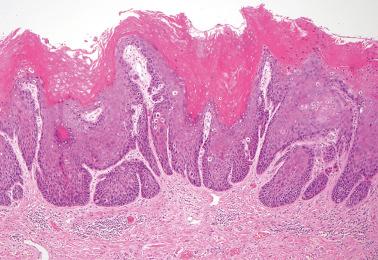
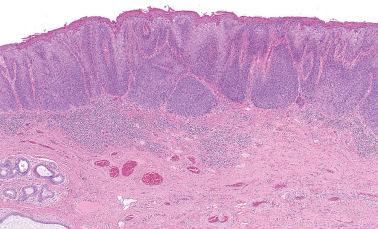
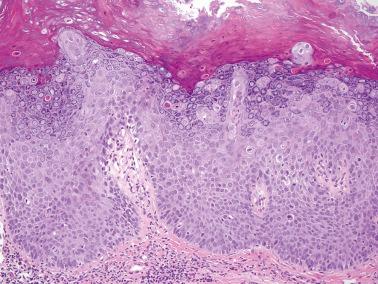
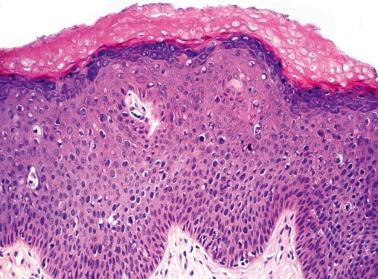
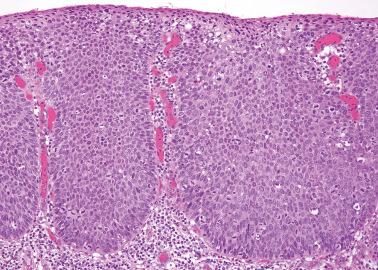


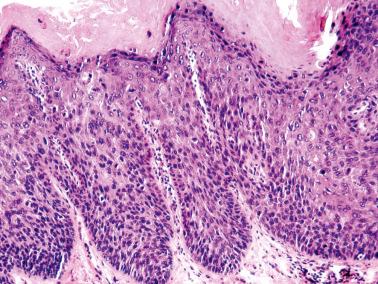
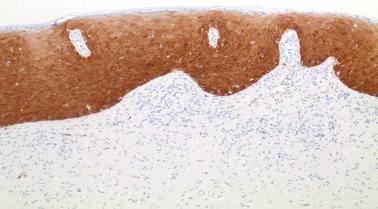
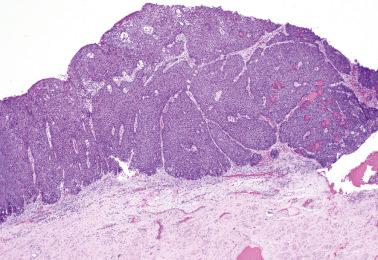
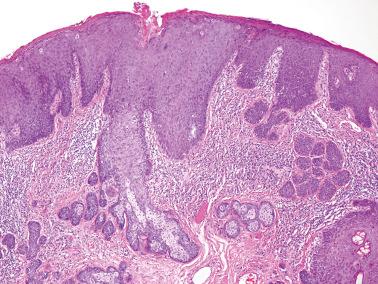
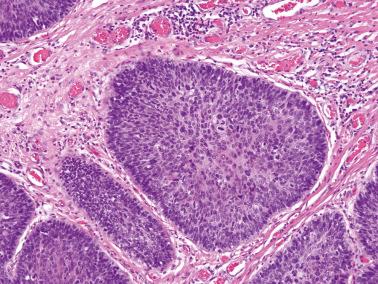
After local treatment, up to 50% of cases of uVIN persist or recur, usually within 5 years. Recurrence has correlated with smoking, multifocality, positive resection margins, and laser (vs surgical) treatment.
Progression to ISqCC is less common than in dVIN, occurring in ~5% of treated women and 10–15% of untreated women. Progression occurs over a longer period compared to dVIN; the risk increases with age and in immunocompromised women.
As noted above, spontaneous regression of uVIN, especially those with the clinical findings of bowenoid papulosis, may occur, particularly in pregnant or postpartum women.
dVIN usually occurs in postmenopausal women. It may be asymptomatic or cause pruritis and/or a visible lesion. The lesions are usually less conspicuous than those of uVIN, appearing as single or multiple gray-white areas with a rough surface or ill-defined white plaques or nodules.
In contrast to uVIN, dVIN is preceded by and/or coexists with lichen sclerosus, squamous hyperplasia, lichen simplex chronicus, or combinations thereof, in 80% of cases. These lesions, which may show atypia, are putative precursors of dVIN.
dVIN is most commonly recognized in women with a synchronous or metachronous keratinizing or basaloid ISqCC that is usually in the vicinity of the dVIN. In contrast, isolated dVIN is commonly under-diagnosed microscopically, one study finding that ~40% of lesions preceding ISqCC initially diagnosed as lichen sclerosus were dVIN.
dVIN is now regarded as the precursor of many or most HPV-negative ISqCCs and, as noted below, is associated with a greater risk of invasion than uVIN.
The epidermis is usually thickened, parakeratotic, with elongated and branching rete ridges. The suprabasilar epithelium is composed of enlarged atypical squamous cells with abundant eosinophilic (sometimes glassy) cytoplasm, prominent intercellular bridges, and large vesicular nuclei with macronucleoli. Dyskeratotic cells, whorls, or keratin pearls may occur in the lower epidermis and rete ridges.
The large atypical keratinocytes contrast with the smaller basal cells that have irregular hyperchromatic nuclei with mild to severe atypia. Mitotic figures are most commonly found in the basilar cells, but also may occur in the upper layers.
Occasionally the atypical cells occupy the full thickness of the epithelium (basaloid dVIN), potentially mimicking basaloid uVIN ( ). Studying HPV-negative keratinizing and basaloid ISqCCs, found that 8% of the associated VINs were basaloid dVIN with epidermal replacement by a homogeneous population of atypical basaloid keratinocytes with the immunoprofile of typical dVIN.
found that intraepithelial mast cells are common in dVIN and may be diagnostically helpful given their absence in benign cutaneous lesions, such as lichen sclerosus.
dVIN often abuts lichen sclerosus and/or squamous hyperplasia. The lichen sclerosus may show atypia, particularly in the lower epidermis, with nuclear enlargement, prominent nucleoli, and occasional normal or abnormal mitotic figures. The cytoplasm of the atypical cells may be pale and vacuolated, potentially mimicking Paget's disease.
Other findings may include prominent spongiosis, involvement of pilosebaceous units, a chronic inflammatory cell infiltrate, and dermal fibrosis.
Subtle foci of microinvasion, which may be a clue to the presence of overlying dVIN, consist of often small, irregular and angulated nests of large keratinocytes originating from the basilar epidermis or rete ridges, sometimes with an inflammatory or desmoplastic reaction.
Immunohistochemical and molecular findings:
p53 reactivity is typically present in at least the lower third of the involved epidermis. Ki-67 reactivity, in contrast to uVIN, is confined to the basal and parabasal layers. The neoplastic cells are typically negative for HPV and p16.
dVIN is typically associated with TP53 mutations, and in some cases the same mutations are present in adjacent areas of ISqCC, supporting a genetic relationship between the lesions.
In 25–30% of dVIN, there is loss of p53 staining (p53-null) that can help in the diagnosis of subtle dVIN and its involvement of resection margins ( ). In such foci there is an abrupt maturational change (keratinocytes with abundant eosinophilic cytoplasm, hyper- and parakeratosis, loss of keratohyaline granules) but only minimal basal nuclear atypia.
found that diffuse suprabasal or full-thickness expression of CK17 strongly supports a diagnosis of dVIN over lichen simplex chronicus, whereas focal or superficial CK17 staining supports the latter diagnosis. This finding, however, is not diagnostic of dVIN as some cases of lichen sclerosus also showed full thickness CK17 positivity.
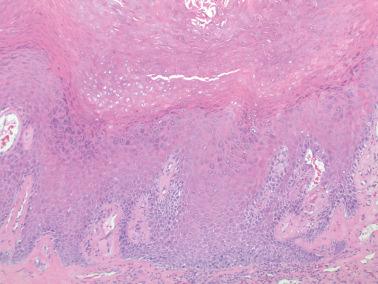

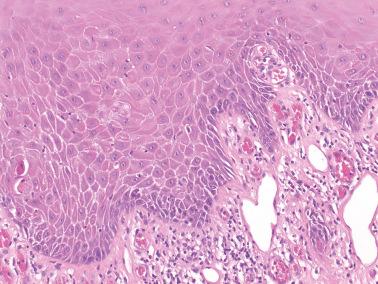
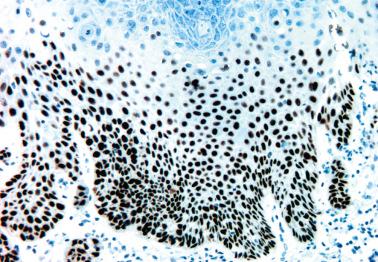
found that dVIN has a greater risk of progression to ISqCC than uVIN and that a third of dVINs progressed sooner (mean 28 months) than uVINs that progressed. found that the median interval between the biopsy specimen showing dVIN and the ISqCC was 43.5 months (range, 8–102 months).
found that 92% of dVINs or dVIN/SqCC had progression to or recurrence of ISqCC, respectively, at a median of 1.1 year; 88% of women died of disease with a median OS of 3.4 years.
Condylomas with pseudobowenoid change and condylomas with podophyllin effect ( Chapter 1 ).
Inflammatory and reactive atypia and multinucleated keratinocytes ( Chapter 1 ).
Lichen sclerosus or squamous cell hyperplasia with atypia (vs dVIN).
Features favoring or indicating dVIN includes prominent parakeratosis, a thickened epidermis with elongated and branching rete, abnormal keratinocytes with large vesicular nuclei, macronucleoli, abundant eosinophilic cytoplasm, squamous whorls, and keratin pearls.
Strong continuous p53 staining of basilar cells, sometimes with suprabasilar extension of the staining, or a p53-null pattern (see above) also favors dVIN.
Erosive lichen planus (LP) (vs dVIN). described cases of erosive LP with maturational and nuclear changes (and in some, synchronous lichen sclerosus) that raised concern for dVIN. A clinical appearance typical of LP, wild-type p53 staining in some cases, and copy variant analysis showing patterns similar to the adjacent dermis facilitated the diagnosis.
Differentiated exophytic vulvar intraepithelial lesions (see next heading).
Paget's disease and radial growth of malignant melanoma.
In both disorders, the malignant cells are usually individually disposed and surrounded by benign keratinocytes. Glands and/or signet-ring cells indicate Paget's disease. A possible source of confusion are rare VINs with mucinous differentiation, that unlike Paget's, contain dysplastic keratinocytes ( ).
Special stains show mucin, CEA, and CK7 in Paget's cells, and S100 and HMB45 in melanoma cells. As noted above, pagetoid VIN may also be CK7+, but other markers noted above facilitate its distinction from Paget's disease.
have applied this term to atypical verruciform vulvar lesions of which 73% and 55% contained mutations in PIK3CA and ARID2 , respectively; no TP53 mutations were found. A control group of typical keratinizing SqCCs contained TP53 and CDKN2A mutations.
In one patient, an atypical verruciform lesion with PIK3CA mutations was followed by a keratinizing SqCC with mutations in both PIK3CA and TP53 .
These authors speculate that although PIK3CA mutations are found in <10% of vulvar SqCCs, such mutations may be specific for a particular pathway involving atypical verruciform lesions that potentially act as a direct precursor or risk factor for vulvar SqCC.
ISqCCs account for 90% of vulvar cancers and 5% of gynecologic cancers.
Two pathogenetic pathways exist:
An HPV-related pathway in ~50% of ISqCCs, usually in premenopausal women, leads to warty and basaloid ISqCCs. It is commonly associated with one or more of: HPV infection (including a history of genital warts), uVIN, smoking, cervical cancer risk factors, immunosuppression, and squamous neoplasia of the cervix or vagina.
A p53-related pathway in ~40% of cases, which usually occurs in women in the seventh to eighth decades of life, leads to keratinizing ISqCC. It is usually not related to HPV but is associated with one or more of: dVIN, lichen sclerosus, squamous cell hyperplasia, and p53 mutations.
The two pathways may act in synchrony: almost 40% of LS-associated ISqCCs were HPV+ in one study. Similarly, a third of keratinizing ISqCCs in another study were associated with uVIN. Some tumors are negative for both HPV and p53, suggesting other factors such as ISqCCs complicating chronic hidradenitis suppurativa.
found that morphologic assessment and p16 staining are concordant in classifying vulvar ISqCCs as HPV-independent or HPV-associated in 83% of cases. Most of the discrepant tumors were p16+ well-differentiated keratinizing SqCCs, 94% of which were HPV+ by PCR.
found that HRHPV E6/E7 mRNA in situ hybridization covering 18 high-risk HPV types (‘HR-RISH’) is 97% sensitive for PCR+ and p16+ anogenital HSILs and ISqCCs.
Rarer molecular findings in vulvar ISqCCs have included HER2 overexpression and amplification (potentially allowing for targeted therapy) ( ) and CDKN2a (p16), HRAS , and PIK3CA mutations in HPV-negative women ( ).
The usual presentation is a vulvar mass that may be pruritic, painful or bleeding; a groin mass is an occasional presentation. A persistent ulcer may be the only presenting finding, particularly in a postmenopausal woman. Stage III or IV disease is found at the time of treatment in as many as a third of patients.
Clinical and gross examination reveals a raised, occasionally warty or ulcerated mass that involves, in descending order of frequency, the labium majus, the labium minus, the perineal body/posterior fourchette, and the clitoris. About 10% of lesions are multifocal. Rare tumors are endophytic with minimal surface abnormality ( ).
As noted above, the main histologic subtypes of ISqCC are keratinizing, basaloid, and warty, which occasionally coexist; some tumors have overlapping features. Keratinizing ISqCCs account for 65–80% of vulvar ISqCCs and basaloid and warty ISqCCs combined account for the remaining 20–35%.
Keratinizing ISqCCs resemble typical ISqCCs at other sites. They may be papillary or polypoid, and are usually well or moderately differentiated, with varying degrees of squamous maturation and keratin formation and an absence of koilocytosis.
Common adjacent lesions include typical or atypical lichen sclerosus, squamous hyperplasia, and dVIN (or uncommonly, uVIN).
Most tumors are p53+ and exhibit TP53 mutations, which may also be present in foci of synchronous dVIN; p16 staining in usually absent or weak and focal. PCR testing usually reveals no HPV, although HPV has been present in a minority of tumors in some studies.
found that 43% and 86% of vulvar SqCCs (subtypes not specified) had positive PD-L1 expression in tumor cells and tumor microenvironment immune cells, respectively. They suggested that these findings potentially warrant investigation into use of immunotherapy in targeting the PD-1/PD-L1 pathway in vulvar SqCCs.
found that a minority of tumors exhibit EGFR gene amplification.
Basaloid and warty ISqCCs.
Basaloid ISqCCs are composed of basaloid cells with scanty cytoplasm that typically grow in bands, sheets, or nests within a desmoplastic stroma. Focal cytoplasmic maturation and keratinization can occur, usually with an abrupt transition with the basaloid cells.
Warty ISqCCs resemble warty VIN except for invasion as bulbous or irregular jagged nests, often with prominent keratinization. The koilocytotic tumor cells have pleomorphic to bizarre, often multiple, nuclei with irregular contours that vary from hyperchromatic and shrunken to those with clumped or smudged chromatin.
In both types, contiguous uVIN is present in 80% of cases.
The tumor cells typically show strong diffuse p16 staining (due to HRHPV integration) but usually normal p53. found SOX2 copy number increases in a substantial minority of high-grade HPV+ vulvar basaloid SqCCs.
There is no widely accepted grading system for vulvar ISqCCs.
grade keratinizing ISqCCs as well differentiated (discrete nests with central keratinization and cells with low-grade nuclear features), poorly differentiated (diffuse stromal infiltration as small nests and cords, little or no keratinization, high-grade nuclear features), and moderately differentiated.
The Gynecology Oncology Group (GOG) grading scheme is based on the proportion of the tumor that is ‘undifferentiated’ (UC) (small cells with scanty cytoplasm infiltrating as small nests or cords): grade 1, no UC; grade 2, 1–30% UC; grade 3, 31–50% UC; grade 4, >50% UC.
Other findings:
Some tumors exhibit a fibromyxoid stromal response, a finding with prognostic implications (see below).
found that staining for cytokeratin and collagen IV facilitated the diagnosis of very superficial invasion. In contrast to VIN, early invasive nests had an absent or discontinuous basement membrane investment.
found immunohistochemical expression of epidermal growth factor in 83% of HPV-unrelated vulvar SqCCs (vs 15% of HPV-related tumors), two-thirds of which were also positive by ISH.
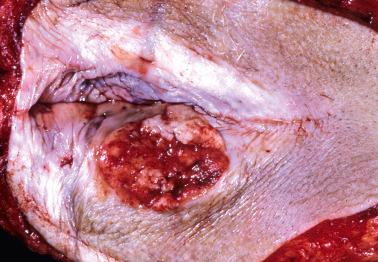

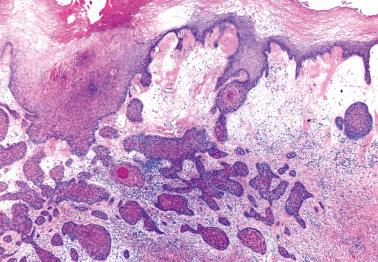

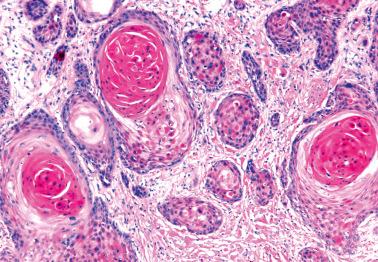
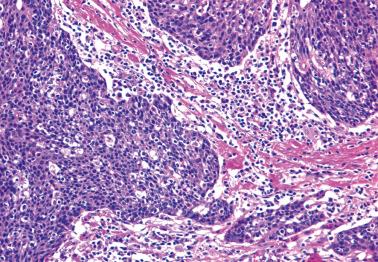
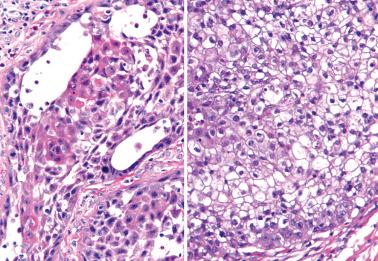
Amelanotic malignant melanoma. This tumor usually has a junctional component, lacks keratinization, and is S100+/HMB-45+.
Epithelioid sarcoma (see corresponding heading). Findings favoring this diagnosis are a deep location, zonal necrosis, rhabdoid cells, positivity for mesenchymal antigens, and an absence of VIN and keratinization.
Basal cell carcinoma (BCC) (vs basaloid ISqCC). Features favoring BCC include: a lobular well-circumscribed contour; low-grade atypia; peripheral palisading; no VIN; diffuse staining for BerEP4 (except in markedly squamatized BCCs), CK14, and CK17; lack of diffuse staining for p16; and absence of HPV by ISH.
Metastatic small cell carcinoma and Merkel cell tumor (vs basaloid ISqCC). These tumors tend to have a highly infiltrative pattern (often with single cell invasion), smaller cells with scanty cytoplasm, and positivity for neuroendocrine markers.
Verrucous carcinoma (vs warty SqCCs and papillary keratinizing SqCCs). Features indicating verrucous carcinoma, which is rare, include absent or minimal cytologic atypia, usual absence of koilocytosis, and a well-circumscribed deep border formed by rounded bulbous masses.
| Stage I | Tumor confined to the vulva and/or perineum, ≤2 cm in greatest dimension |
| IA | Depth of invasion a not exceeding 1 mm |
| IB | Depth of invasion >1 mm |
| Stage II | Tumor confined to the vulva and/or perineum, >2 cm in greatest dimension |
| Stage III | Tumor invades any of the following: lower urethra, vagina, anus, and/or unilateral regional lymph node metastasis (N1) |
| Stage IVA | Tumor invades any of the following: upper urethra, bladder mucosa, rectal mucosa; and/or is fixed to bone; and/or bilateral regional lymph node metastasis |
| Stage IVB | Any distant metastasis, including pelvic lymph nodes |
a Depth of invasion is defined as the distance of the tumor from the epithelial–stromal junction of the adjacent most superficial dermal papilla to the deepest point of invasion.
Clinical factors.
Stage . 5-year survival rates are 85–98%, 60–85%, 40–74%, and 10–30% for stages I to IV, respectively.
Other adverse prognostic factors . These include older age, smoking, and fixed or ulcerated groin nodes.
Features of the primary tumor.
Depth of invasion . Tumors invading ≤1 mm (measured from the most superficial dermal papilla adjacent to the tumor's deepest focus of invasion) (FIGO stage IA) have a <1% risk of nodal spread vs 6% and 20% for tumors invading 1.1–3 mm and 3.1–5 mm, respectively ( ). Diagnosis of the presence and/or measurement of depth of superficial invasion, particularly in stage IA tumors, can be problematic ( ). found that measuring from the nearest dysplastic rete ridge to the deepest invasion downstaged 19% of IB tumors to IA. The downstaged tumors had fewer recurrences and better survival than those that remained IB.
Tumor grade . found that survival decreased with increasing grade.
Lymphovascular invasion (LVI). found LVI to be a strong predictor of inguinal nodal spread. LVI was found in 40% of ISqCCs, a frequency that increased to 65% when the endothelial marker D2-40 was used.
Perineural invasion . found that perineural invasion was a predictor of recurrence that was independent of depth of invasion, nodal involvement, LVI, and stage.
Fibromyxoid stromal response. This feature is associated with an infiltrative tumor morphology, deep invasion, perineural invasion, nodal spread, and extranodal extension ( , , ).
HPV-associated vs HPV-independent tumors. p16+ tumors (indicating HRHPV) with wild-type p53 expression have a more favorable prognosis than p16−/p53 mutational tumors ( , , ). Similarly, found that HPV+ and/or p16+ tumors had better postradiation survival and lower local relapse rates; found that p53+ tumors were 3x more likely to recur and 7x more likely to be fatal. Most strikingly, found that all 18 patients with dVIN-related (HPV−) ISqCCs died of disease ( , ). Of note, the AJCC 8th edition staging system added classification of p16 status to be included if obtained (not required).
En-bloc vs localized resection . In another study, found that HPV-independent ISqCCs that were managed by localized radical operations with separate vulvar and nodal resections had worse outcomes (PFS, DSS, OS) than those managed by en-bloc radical resections.
Other adverse factors . These have included basaloid subtype, multifocality, associated uVIN, infiltrative (vs pushing) pattern of invasion, minimal mononuclear inflammatory infiltrate, p53 over-expression, diffuse MIB1 staining, and increased EGFR gene copy numbers. found that tumors with somatic mutations, especially HRAS-mutations, had a significantly worse prognosis than patients lacking these changes.
Lymph node involvement.
Inguinofemoral nodes are involved in 30–40% of cases, with bilateral involvement in about one-third. found that the predictive value of a negative inguinal sentinel lymph node was 100%. Pelvic lymph nodes are involved in 5% of cases overall, in 25% of cases with involved inguinofemoral nodes, and rarely if ever when the inguinal nodes are negative.
Recurrences, which develop in 50% of patients with involved inguinofemoral nodes, are associated with 40% 5-year survival vs 85% for those with negative nodes.
Involvement of ≥3 inguinofemoral nodes, bilateral nodal involvement, extranodal tumor, and pelvic nodal involvement are additional adverse prognostic factors.
found that the lymph node ratio (LNR) (ratio of positive nodes to total number of nodes) was associated with OS whereas the number of positive nodes was not. LNR ratios of 0%, >1–<20%, and >20% were associated with 5-year OS rates of 90.9%, 70.7%, and 61.8%.
Cytokeratin staining detected micrometastases in inguinal nodes in 23% and 42% of patients in two studies. One of them found that nodal metastases were associated with an almost 20-fold increased risk of recurrence compared to those with negative nodes.
Regauer found that cytokeratin staining was helpful in detecting micrometastases in sentinel nodes, including single tumor cells and anucleate cells. Single tumor cells were particularly common in LS-associated ISqCCs.
Recurrences.
found extravulvar recurrences were associated with a poor survival compared to those with a vulvar recurrence (12% vs 62%, respectively). found that distant metastases (lung, liver, bone, lymph nodes) accounted for 5% of recurrences, with a subsequent 2-year survival of 11.3%.
found that aggressive locally recurrent tumors were often associated with persistent high-grade VIN and LS. Regauer found that almost 50% of LS-related ISqCCs recurred within residual anogenital LS. Similarly, found that women with LS-related ISqCCs had an increased risk of post-treatment local recurrence or a second primary ISqCC.
Verrucous carcinomas (VCs) are rare highly differentiated SqCCs. No definite association with HPV or p53 mutations has been found although some have been associated with one or more of: lichen sclerosus, lichen simplex chronicus, and a distinctive type of acanthosis described below. In the largest series, two-thirds of VCs were stage II or greater. Misdiagnosis of prior biopsy specimens as squamous papilloma or condyloma may cause a delay in diagnosis
VCs typically occur in women in the late reproductive and postmenopausal age groups who present with pain, pruritus, and a large, gray-white, fungating mass on the labium majus. As noted above, local structures may be invaded.
The tumors have a papillary architecture with prominent acanthosis, hyperkeratosis, and a deep pushing invasive border composed of broad bulbous pegs. Koilocytosis is absent.
The neoplastic squamous cells have abundant eosinophilic cytoplasm and absent to mild nuclear atypia. Mitoses, if present, are confined to the basal layers, as are most Ki-67+ cells.
‘Vulvar acanthosis with altered differentiation’ ( ) designates a distinctive squamous proliferation that often abuts VCs and may be its precursor or risk factor. It is characterized by marked acanthosis with variable verruciform architecture, loss of the granular layer with superficial epithelial cell pallor, and multilayered parakeratosis.
VCs should be distinguished from condyloma ( Chapter 1 ), warty carcinoma (see corresponding heading), and papillary but otherwise conventional SqCCs that are distinguishable from VCs by the presence of more than mild nuclear atypia and an infiltrative border.
found a 17.5% recurrence rate. As VCs rarely, if ever, metastasize, metastases should prompt thorough sampling of the primary tumor to exclude a component of conventional ISqCC that can rarely arise in an otherwise typical VC.
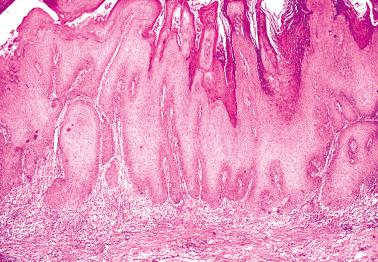
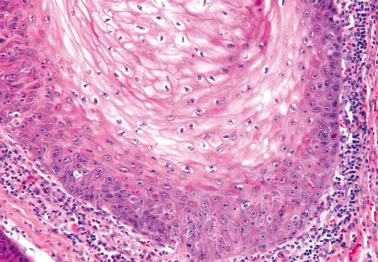
Sarcomatoid (or spindle cell) vulvar ISqCCs typically occur in postmenopausal women; at least half are stage II or greater. Rarely such tumors may follow radiation treatment for a usual SqCC. Some have been associated with lichen sclerosus and/or dVIN.
Microscopic examination reveals high-grade spindle cells that often merge with foci of typical ISqCC. Rare tumors have had malignant heterologous elements. found diffuse staining for cytokeratins, vimentin, p63, and p53; all were HPV-negative. However, similar to sarcomatoid squamous cell carcinomas at other sites, cytokeratin staining may be focal to weak.
The differential diagnosis is with a sarcoma or spindle cell melanoma. Merging of the spindle cells with typical ISqCC, focal keratinization, and at least focal cytokeratin staining are diagnostic.
The tumors are aggressive; most patients die of disease or are alive with disease at last follow-up.
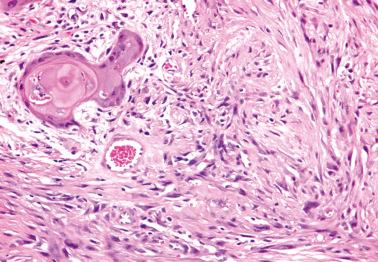
Acantholytic ISqCCs have prominent spaces simulating glands (‘adenoid’ or ‘pseudoglandular’ SqCC) or vascular spaces (‘pseudoangiosarcomatous’ SqCC). These tumors may be more aggressive than typical ISqCCs.
Rare ISqCCs have numerous tumor giant cells creating a resemblance to giant cell carcinomas in other sites.
ISqCC has been a component of two vulvar carcinosarcomas; the sarcomatous component was osteosarcoma in one case and leiomyosarcoma in the other.
The three reported vulvar lymphoepithelioma-like carcinomas were EBV−. One tumor recurred locally and in inguinal lymph nodes 4 months after resection.
The one reported ‘plasmacytoid’ squamous cell carcinoma we would interpret as an undifferentiated carcinoma with plasmacytoid features as reported in other sites.
Paget's disease (PD), which accounts for ~1% of vulvar cancers, occurs in the late reproductive and postmenopausal age groups, with median and mean ages in the seventh decade. PD may be present for years before a diagnostic biopsy is performed.
The usual presentation is that of pruritic or burning, eczematoid, erythematous, weeping patches interspersed with white (hyperkeratotic) or ulcerated areas. Early PD is usually confined to the labia, but longstanding PD may also involve the mons, clitoris, urethra, perianal area, and medial aspect of the thighs. Rarely the vaginal, ectocervical, or even endocervical mucosa may be involved.
About 30% of patients have a synchronous or metachronous carcinoma, most commonly of the breast or genitourinary system (uterine cervix, urinary bladder). With rare exceptions (see next section), these tumors are unrelated to the vulvar disease.
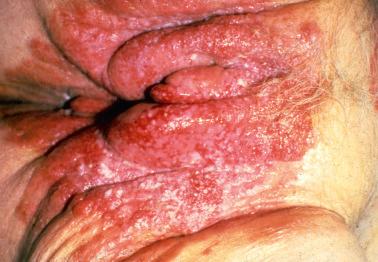
Most cases begin as a primary cutaneous in situ carcinoma, likely originating from adnexal stem cells, the cells of the poral portion of the sweat ducts, or from anogenital mammary-like glands ( Chapter 1 ) that include the clear cells of Toker (see below). Involvement of skin appendages reflects pagetoid spread of the tumor cells or multifocal disease, not an underlying sweat gland carcinoma.
Rare cases represent secondary vulvar involvement by a regional internal cancer, most commonly of the anorectal region or urinary tract. A primary rectal adenocarcinoma should be excluded in cases with vulvar and perianal involvement.
Large malignant epithelial cells are disposed singly, in clusters, and occasionally as glands within the epidermis. The concentration of tumor cells is usually greatest in the basal layer, but in most cases all epidermal layers, the pilosebaceous units, and the poral and dermal portions of sweat ducts are also involved.
The typical Paget cell has a vesicular nucleus with a prominent nucleolus and abundant pale amphophilic cytoplasm that usually contains mucin demonstrable with mucin stains, but it may be scanty and difficult to find in a small biopsy specimen. Signet-ring cells with abundant cytoplasmic mucin may be present.
Involvement is typically much more extensive and more multifocal than appreciable on clinical or gross examination; cutaneous resection margins are commonly involved.
Paget cells are diffusely and strongly CK7+ which is a good marker for in situ and invasive Paget cells, distinguishing them from hyperplastic and malignant squamous cells, which are CK7−.
Paget cells also usually stain for GATA3, CEA, CAM 5.2, GCDFP, MUC1, and AR but are negative for CK20, p63, PAX8, SOX10, ER, and PR ( ).
Her-2/neu positivity has been found in 40–60% of cases. p53 positivity correlated with dermal invasion in one study.
found that the mean scores of AR and androgen-producing enzymes were significantly higher in invasive PD than in noninvasive PD.
found two cases of PD in which strongly p16+ Paget cells effaced keratinocytes and mimicked uVIN; 4 of 5 additional cases showed variable p16 staining.
In up to a third of cases, invasion (often unsuspected clinically) is found on microscopic examination.
The detection of rare invasive cells in the superficial dermis can be facilitated by CK7 staining.
The depth of invasion in millimeters (measured from the basement membrane) and the presence or absence of lymphatic invasion should be noted.
Rarely the invasive tumor may exhibit overt mucinous ( ) or signet-ring differentiation (Jeong and Kim).
Brainard and Hart found that a third of vulvar PD had a superimposed squamous proliferation categorized, in order of frequency, as: papillomatous squamous cell hyperplasia (SCH); SCH, NOS; and fibroepithelioma-like SCH.
These changes can result in a misdiagnosis of a benign squamous lesion if Paget cells are rare, or a malignant squamous lesion if Paget cells are numerous and diffusely distributed.
In several cases, small dermal nests of squamous cells simulated microinvasive squamous carcinoma.
reported syringocystadenocarcinoma papilliferum-like changes in extramammary PD, with acanthosis, papillomatosis, Paget cells replacing the keratinocytes in the spinous later (sparing the basal layer), and a prominent dermal infiltrate of plasma cells.
Rare cases of vulvar PD are associated with other vulvar lesions, such as synchronous VIN, ISqCC, or malignant melanoma.
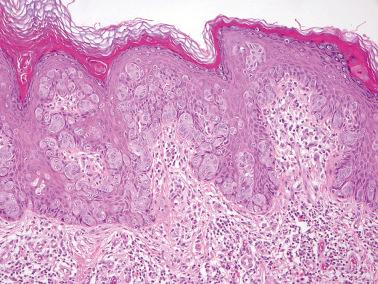
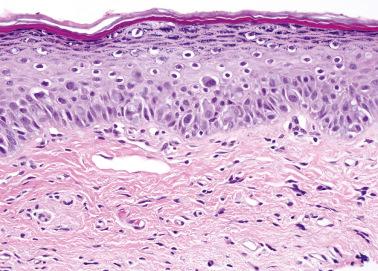
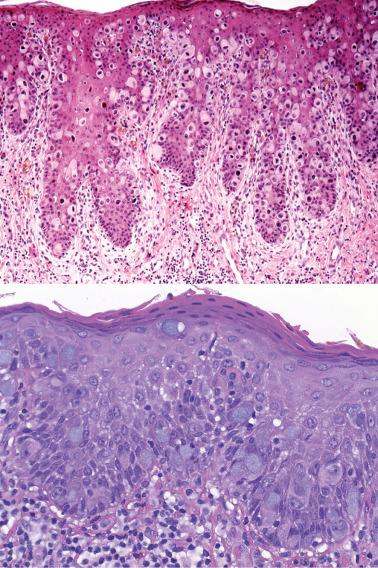
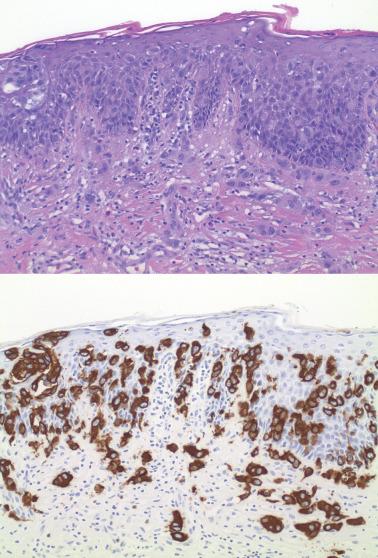
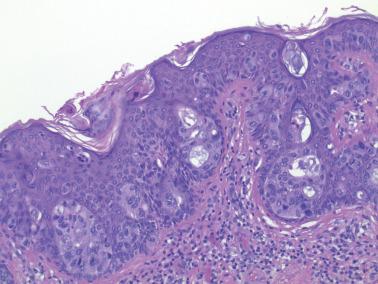
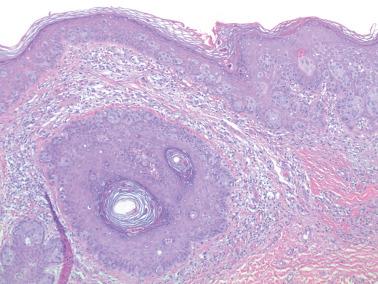
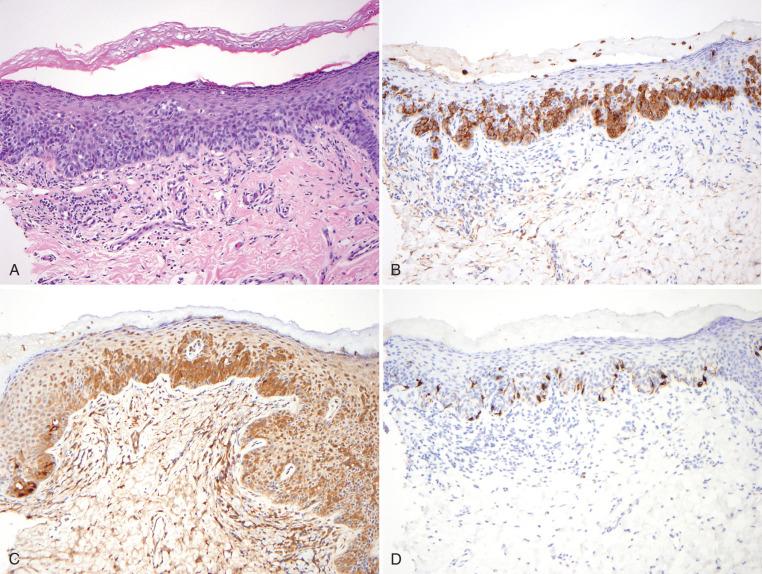
Clear cells of Toker.
These are intraepidermal cells with clear to pale cytoplasm that can be associated with mammary-like gland ducts ( ; ). They are considered a normal incidental microscopic finding although it has been proposed that they may be a precursor of vulvar PD.
Their pagetoid distribution as well as PASD and CK7 positivity may suggest PD, but awareness of their occurrence, the absence of clinical findings, and bland nuclear features facilitate the diagnosis.
Pagetoid VIN (see corresponding heading).
VIN with mucinous differentiation. The presence of dysplastic and p16+ squamous cells supports this diagnosis.
In situ malignant melanoma. In contrast to Paget cells, melanoma cells lack mucin and stain for one or more of S100, HMB-45, Melan-A, and SOX10, but not CK7. As cytoplasmic melanin can occur in Paget cells, it is not a differential feature.
Pagetoid spread from an extravulvar primary. Such tumors will have the immunoprofile of the primary tumor. Some may be CK7+, but unlike vulvar PD, are typically CK20+, GCDFP−, and GATA3−. Pagetoid urothelial tumors, however, would be GATA3+ but unlike primary vulvar PD would also be uroplakin+/p63+/thrombomodulin+ ( ). PD from colorectal carcinomas would be CDX2+/SATB2+.
Rarer lesions in the differential (see ) include pagetoid Spitz nevus, pagetoid dyskeratosis ( Chapter 4 ), clear cell papulosis, epidermal involvement by sebaceous carcinoma, Merkel cell carcinoma, eccrine porocarcinoma, cutaneous T-cell lymphoma, and lesions of Langerhans’ cells (histiocytosis X, Langerhans’ cell microabscesses).
Intraepidermal recurrence occurs in up to 60% of cases due to incomplete excision; rarely, recurrences are within the vaginal and cervical mucosa ( ). In most studies, the risk of recurrence does not correlate with resection margin status.
Multiple recurrences may occur over a period of many years. Rarely, there is progression to invasive PD during the follow-up period.
Minimal dermal invasion (<1 mm), with rare exceptions, does not appear to affect prognosis, whereas tumors with deeper invasion may spread to inguinal nodes and other sites with a potentially fatal outcome. found that their cases of invasive PD had a mortality rate of 40%.
Other findings that may increase the risk of local recurrence include acantholysis within the epidermal tumor and Her-2/neu expression.
These tumors, which account for <5% of vulvar carcinomas, occur in the reproductive and postmenopausal age groups (median age, 50 years). HPV has been found in some tumors.
Criteria for the diagnosis proposed by Chamlian and Taylor were as follows: transition between the normal gland and tumor; involvement of the area of Bartholin's gland; histologic compatibility with Bartholin origin; and no evidence of a primary tumor elsewhere.
The presentation may include a mass, pain, pruritis, bleeding, discharge, or combinations thereof. In up to 50% of patients, an initial misdiagnosis of Bartholin's gland cyst or abscess causes diagnostic delay. In a large series, the FIGO stages were I in 25%, II in 42%, III in 28%, and IV in 5%.
The approximate frequencies of the most common types are: SqCC (rarely in situ), 40%; adenocarcinoma, NOS, 25%; and adenoid cystic carcinoma (ACC), 12%.
Rarer types have included adenosquamous carcinoma, transitional cell carcinoma, epithelial–myoepithelial carcinoma, small cell neuroendocrine carcinoma, and undifferentiated carcinoma (one with paraganglioma-like features). Single examples of Merkel cell carcinoma, clear cell adenocarcinoma, lymphoepithelioma-like carcinoma, and a salivary gland-type basal cell adenocarcinoma have also been reported.
found that 6 of 9 vulvar ACCs had NFIB rearrangement, two of which were positive MYB rearrangement confirmed by a MYB–NFIB fusion pattern.
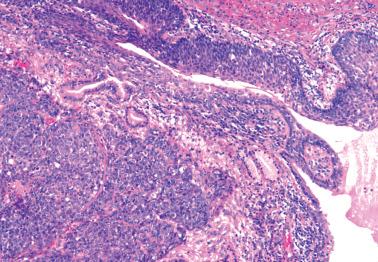
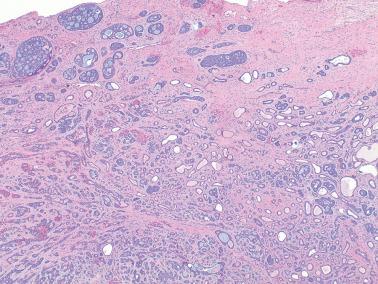
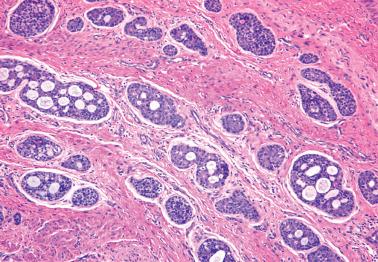
Become a Clinical Tree membership for Full access and enjoy Unlimited articles
If you are a member. Log in here